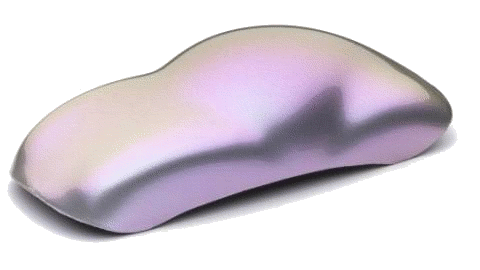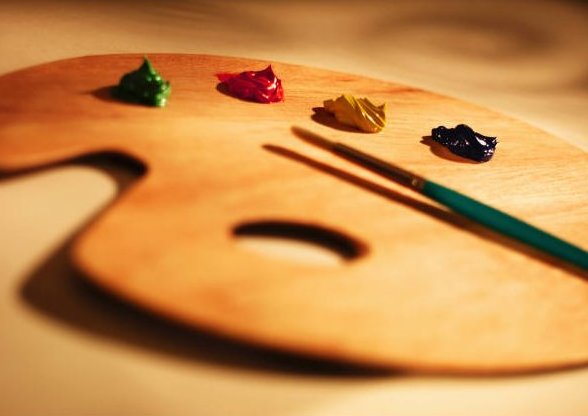World of Colour
This section outlines the wide variety of uses that colour has in the world around us. You can learn about how animals use colour for protection, hunting and attraction. You can also learn about how colour is applied in the products we use everyday, from cars to cosmetics. In the art section are details about how artists use colour. There are also sections on plants and safety.
Animals

Animals use colour for a variety of reasons.
Protection
The milk snake is coloured red and black to give the impression that it is poisonous, when it actually isn't!! Other poisonous snakes are coloured like this, so predators learn not to eat snakes of this colour. This is a type of mimicry (Müllerian mimicry) where an animal mimics the attributes of a poisonous creature, when it actually is itself harmless to protect itself.
Stick insects also use their colour to merge into the background in order to mimic twigs.
Hawkmoth larvae are caterpillars that look like snakes from behind!! This is Batesian mimicry, and is where an animal looks like something it isn't.
Arctic rabbits change the colour of their fur depending on the weather. They are white in the winter so they can blend into the background snow and brown in the summer when there is less snow.
Zebras use their colours to hide from predators. They don't hide in their surrounding environment but with each other. Their unique patterns breaks up their individual outlines, making it hard for a predator to single out one particular animal. This makes them less willing to attack if they do not have a specific target.
Hunting

Animals use colour as a camouflage so that they can creep up on other animals and get close enough to attack or pounce. For example camouflage is used by lions, tigers and snakes.
Sharks tend to be dark on the top and light on the bottom. This is so that any animals looking down on them won't see them against the darkness of the deep, and any animals looking up towards them won't be able to spot them against the light of the sky!!
Attraction
Animals use colour to attract each other by showing colourful body parts or displays of colour. An example is peacocks, who use their bright coloured feathers to attract the females.
Man-made Applications of Colour
Plastics

Coloured pigments are widely used within the plastic industry. The coloured plastics can then be used within food packaging, toys, phones, stationary, etc. The types of pigments used are usually synthetic pigments made by the industry due to them being safe and very easy to make - especially on a large scale. Natural pigments are not always easy to come by and so the process of extracting the colour is more difficult. The pigment is added to the molten plastic and then mixed in thoroughly. A small quantity is run out (cast off) to check that the pigment is evenly distributed into the plastic before it is then molded into its correct shape.
Cars

One use of pigments is within car paints. The most popular pigments at the moment are the pearlescent and lustre coloured pigments. The car paint is usually pre-mixed, and then applied to the car.
Red coloured pigments used within car paint pose the most problems due to their tendency to fade. This is due to the pigment being unstable to light. Research is currently being carried out to replace the existing red pigments with metallic reds or a brighter more stable colour, which tend not to lose their colour under intense sunlight.
Cloth
Pigments do not to dissolve in water, therefore they can not be used to dye clothes.
Dyes will dissolve in water, which allows the coloured particles to get between all the strands in the cloth. The dye will chemically bind with the cloth so that it won't run when washed, making it very useful for clothes.
Most companies use synthetic colours - which are cheaper and more readily available than natural ones - as this means that the garments are cheaper for us at the end of their process.
Cosmetics

Cosmetics have been fashionable throughout history, and have helped to define fashion. The Egyptians and Elizabethans tended to wear make-up that was lead based, as fashion dictated that women with a fair complexion were beautiful. The only problem with this was that lead causes skin cancer, and the skin would be very pitted and diseased.
Over the years make-up fashions have come and gone, but the need for flawless skin has never been lost. We have moved far away from the white lead and vinegar of the Elizabethan era to lustre colours, which help give two tone effects which gives a flawless look yet is also glittery. Lustre colours and other synthetic pigments are slowly replacing the traditional cochineal and fish-silver pigments that were used in days gone by.
Art

Pigments are used widely within art, they can be used in their raw powdered form or used as a pre made paint. Artists like to explore with their paints by varying the binders they use, the pigments they use, and/or the solvents. This allows them to vary the thickness and the texture of the paint and thus giving different effects to the artwork. Many paints are already made such as water colours, oil paints and poster paints. These are only made using the same three ingredients of a binder, pigment and solvent. Pigments are not only used in paints - they are also used in chalks and pastels.
Plants

Plants use colour and coloured pigments within parts of themselves for a variety of reasons.
Protection
Plants can use colour to protect themselves from being eaten by animals. By appearing red or bright oranges animals are warded off as they are warning colours. Bright colours, such as red, can indicate that they are poisonous and so should not to be eaten, in the same way as some snakes and insects are red or orange. They also use spines and thorns to deter animals.
Predation
Plants use colour to attract insects to them, this allows them to trap the insects and use nutrients from their bodies. The Venus fly trap is a classic example, it has a red section to the plant head which acts like a run way for flies and thus attracts flies and insect, encouraging them to land. When the sensory hairs within the Venus Fly Trap are touched, it creates an immediate reaction to snap round the insect, trapping it inside.
Attraction
Plants use colour pigments within their petals to attract insects to them to allow a process called pollination to occur. The insects are rewarded with nectar and so as time goes on the insects know the colours and patterns of the plants that reward them, so they will keep going to those plants.
Making Food
Plants use a special substance called chlorophyll which appears to be green in colour to the human eye. This substance absorbs sunlight (red and blue wavelengths of light) and uses the energy to make sugars which the plant needs in order to grow big and tall. Chlorophyll does not absorb the green wavelengths of light so this light is mainly reflected giving the plant a green colouration.
Safety

Safety is very important to all of us, it helps us to not get hurt and to protect us from potentially dangerous environments. Coloured pigments play a large role in our safety - they are used in road signs, lighting, and there are even special pigments called thermochromic and photochromic, which are used within everyday items to help us.
Thermochromic pigments can be used in kettles to help warn people when the water is hot by changing colour. They can also be used on eggs, to show when your egg is cooked properly. They are also used on baby bath mats to warn a parent if the water is too hot for the baby, as well as baby spoons which warn if the food is too hot. There are also lots of novelty toys such as rubber ducks, mugs, rings, pencils and clothes, but these aren't necessarily safety related!!
Photochromic pigments are used in lenses for glasses, the lenses changes colour when exposed to sunlight so that they become tinted and help to protect the wearers eye. These pigments are also used in novelty items such as beads and clothes.






